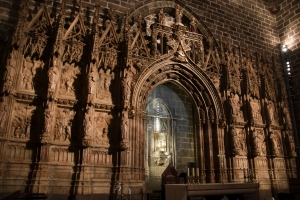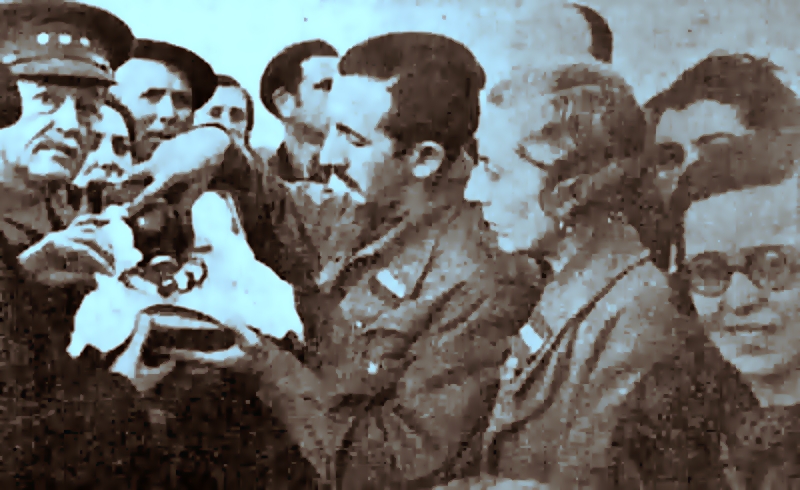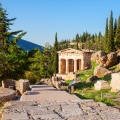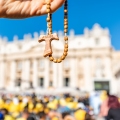In the heart of Valencia, amid the turmoil and smoke of the 1930s, an extraordinary yet little-known story unfolded. It is the story of María Sabina Suey Vanaclocha, a young woman who, without seeking fame, played a crucial role in safeguarding one of Spain’s most significant cultural artifacts during the Spanish Civil War: the Holy Chalice or Holy Grail, long venerated as the cup used at the Last Supper.
Throughout history, individuals have risked their lives to protect this revered relic. According to legend, the deacon Lawrence transported the chalice from Rome to Huesca to shield it from danger. Centuries later, tradition holds that Acisclus and his niece hid it in the caves of Yebra de Basa during the early medieval period. Yet María Sabina’s actions, set against the backdrop of the 20th century, belong not to legend but to the realm of documented fact.
A Relic in Peril
By 1936, as Spain descended into civil war, religious buildings were closed and often targeted for looting and destruction. Valencia Cathedral, the guardian of the Holy Chalice since the 15th century, faced imminent threat. The cup, believed by tradition to have traveled from the Levant to Rome, then to Huesca and Zaragoza before reaching Valencia in 1424 as a gift from King Alfonso the Magnanimous, had become deeply embedded in the city’s cultural and historical identity.
Crafted from dark stone with later medieval additions of gold and precious stones, the chalice was far more than a religious symbol. It represented centuries of history and collective memory. Its loss would have been a cultural tragedy.

The Courage of María Sabina
On 21 July 1936, just hours before an assault on the cathedral, canon Elías Olmos made a desperate decision. He entrusted the Holy Chalice to María Sabina Suey, who had attended Mass earlier that day and lived nearby. Fully aware of the risks, Sabina wrapped the relic in newspaper, concealed it under her arm, and slipped out through a side door into a city gripped by fear and violence.
This decisive act marked the beginning of a clandestine journey that would become one of the most remarkable episodes in the protection of Spanish heritage during the conflict.
A Hidden Journey
Initially, Sabina took the chalice to her mother’s home on Calle Avellanas, hiding it within a concealed compartment in a wardrobe. Despite rumors circulating about its whereabouts, the house withstood two searches without discovery.
Fearing continued risk, Sabina later moved the chalice to her brother Adolfo’s house on Calle Pelayo, where it was hidden among the springs of an old sofa—a piece of furniture still preserved by the family. However, danger persisted, and the chalice was once again moved, hidden behind newly constructed masonry in the kitchen of Sabina’s home. Ultimately, it was transported to Carlet, a small town outside Valencia where the Suey family owned a house.
The transfer to Carlet took place at night and on foot. Sabina’s cousin, Bernardo Primo, and his wife Lidia, carried the relic concealed in a cookie tin placed inside a basket. There, on Calle Padilla (today known as Calle del Santo Cáliz), the chalice was hidden within a sealed window niche, plastered and painted to blend with the wall.
Intrigue and Danger
The mission was fraught with peril. The Suey family home near the cathedral was searched multiple times. In one instance, José Pellicer, a prominent Valencian anarchist, discovered the chalice but chose not to expose it. Later accounts suggest he closed the drawer where it was hidden and warned Sabina discreetly of the danger. His wife would later confirm that this act of silence was decisive in preserving the relic.
Further mysteries surround this story. It is known that the Ahnenerbe, a Nazi organization dedicated to locating objects of supposed historical and mystical significance, conducted searches across Europe beginning in 1935. Rumors persist that Jewish antiquarians in Amsterdam offered seven million pesetas in gold for the chalice, and that a seaplane was prepared in Mallorca to transport it abroad—though no definitive evidence supports these claims.
More concretely, recently declassified research led by Dr. Ana Mafé, published in The Sunday Times, indicates that Britain’s MI6 offered the Suey family safe passage out of Spain by sea in exchange for the artifact. Despite these pressures, Sabina and her family remained resolute: the chalice would stay in Valencia.

A Solemn Return
In March 30, 1939, shortly before the end of the Spanish Civil War, María Sabina Suey, together with her mother and sister, delivered the Holy Chalice to the National Artistic Treasure Recovery Board (Junta de Recuperación del Patrimonio Artístico Nacional) in the presence of canon Elías Olmo. In April 1939, after the official end of the war, the relic was returned to Valencia. As the cathedral remained heavily damaged, a symbolic ceremony was held at the Lonja de la Seda. Accompanied by excerpts from Wagner’s Parsifal, the Holy Grial was formally presented, closing a chapter marked by courage, discretion, and quiet heroism.
Decades later, historian José Francisco Ballester-Olmos reconstructed these events in his book La persecución del Santo Cáliz en la guerra (1936–1939), drawing upon family testimonies, letters, and archival material. Thanks to his work, the full scope of María Sabina’s courageous actions has come to light.
Legacy and a New Path
María Sabina’s story is not merely about a hidden relic. It speaks to the power of ordinary individuals to preserve collective memory under extraordinary circumstances. Her efforts resonate today with the broader initiative known as El Camino del Santo Grial, a contemporary cultural route linking Rome, Naples, and Valencia, and connecting with paths like the Way of Mary Magdalene through Provence.
In safeguarding the chalice, María Sabina Suey became part of a lineage that values heritage and human resilience—a reminder that history is often shaped not by rulers or armies, but by those who, quietly and courageously, choose to protect what belongs to all.
This content comes to you in collaboration with The Way of the Holy Grail, Route of Knowledge, Way of Peace





